|
Carelbi left Sri Lanka and headed for Uligamu, the northern
most atoll in the Maldives, with Anders, our young Danish "sailing-son"
who has now done well over 20,000 nautical miles with us, and Stephen
St Paul, who joined us in Thailand, as crew. Fiona
left to visit her relatives in South Africa since her back no longer
copes with long pasages.
Unfortunately we do not have any photos of the Maldives since
Fiona had our camera and I have not been able to get any of this part
of the passage from either Anders or Stephen. Uligamu was a fascinating
spot. The people were extremely friendly and very pleased to see us. The
water was crystal clear, indeed the first clear water we had seen since
the Pacific. The snorkelling was good, even around the boat in the
anchorage and occasionally we caught glimpses of manta rays circling
Carelbi.
Unlike
Galle, the customs and immigration were honest, a refreshing
change.
After a
relaxing six day stay in Uligamu we reluctantly made sail for Oman. The
passage was a fast one with a reasonable sailing breeze most of the way,
which was a good thing, since one day we were followed by a fishing boat
and managed to creep away at 8 knots under both engine and sail.
************************

The Queen
of Sheba is reputed to have had her capital in what is now Oman, and we
visited the remains of her principal trading port on the Arabian
Sea.

Rumour and legend
insist that Job travelled around this area and his tomb is one of the
tourist sights in the hills behind Salalah.
The photo shows Anders
admiring the decoration and colours.

The photo
opposite shows Carelbi (the small red pencil shape) heading at 6.3 knots
towards the separation zone just as a convoy of around 12 ships
(containers, tramps and large tankers, (shown as red triangles) head
into the protected zone lead by a naval frigate. The position of the boats
are visualised in real time on our computer screen using our AIS
system. Nowadays all large ships are obliged to have an AIS transmitter
which provides information to other vessels around it, such as its name,
course, speed etc. This has been an extremely useful device for us
particularly in restricted busy areas like Singapore, the pirate run, the
Red Sea and the Suez Canal.

The screen
opposite shows Carelbi as the small red pencil shape. A
coalition warship is the black triangle just to the right
of Carelbi. It had just completed several perfect turns around the
separation zone (black track on screen), where it is investigating a
Japanese container ship, disabled by engine problems a very dangerous
situation in a pirate infested zone.
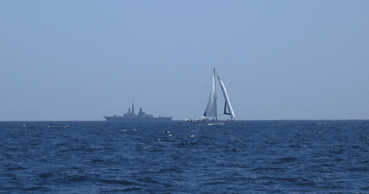
Heidenskip, a beautiful 65 ft Van De Staat, was just behind us
in the convoy.

On
our first day Anders and I were carrying our empty jerry cans looking
for a petrol station. A man in a pick up stopped and offered to show
us around. He arranged to change some US dollars, without cheating us
– very rare in that country, arranged to fill our cans and then took us to
one of the "best" restaurants in town. He could not stay
to eat with us. When we had finished our meal and called for the
bill, the owner said our “friend” had already paid for us. We could not
even say thank you to him, we didn't even know his name.
Most of
the rally disliked Djibouti. We enjoyed it. Anders’ father had a Danish
friend who worked for the World Food Program based in Djibouti. He was a
fascinating person and visited us on Carelbi and entertained us in town.
He told us about some of the problems the UN faces trying to feed the
millions of starving people in the region. All the food comes through
Djibouti and he is in charge of the port logistics.

The first
part of the Red Sea was very enjoyable with strong favourable winds and
good fishing. Anders has landed a barracuda here, not a
fish that is good to eat. Unfortunately, one has to get it on board
and kill it, in order to remove the hook without having a hand
bitten off by its large snapping jaws with their incredibly sharp teeth.

Prew of
Holland ran out of water and is seen here, on the right,
closely following Carelbi as we drag water containers behind us for
them to pick out of the water with their boat hook. Not quite as easy as
it might look...
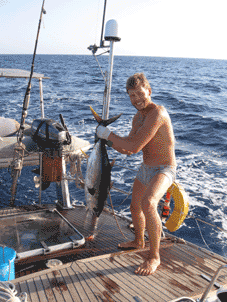
As we
progressed up the Red Sea the passage became more difficult. The winds
were strong and generally contrary. We found ourselves having to motor
most of the way as we wanted to get to Southern Egypt as soon as
possible, for Fiona to rejoin Carelbi, and for Anders to return to Denmark
to begin his career as a medical doctor. Our latest news from him is that
he is loving his work, and has already been
promoted.
|
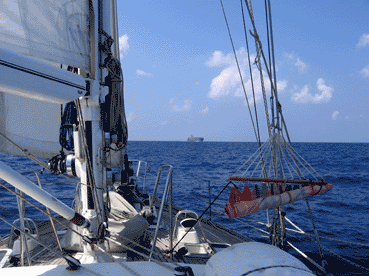
Most likely all they wanted was to sell us
fish but all the boats in the rally were so keyed up about pirates that it
seemed wise not to find out. It is indeed a shame that we react this way,
but that is the reality of today’s sailing in the Middle
East.
**********************
Salalah,
Oman, was a very efficient and very large container port. There was a
sort of English pub nearby where we had various rally meetings and watched
the Six Nation Rugby. A great treat after several months out of
Europe.
The Omanis
are the most likeable Arabs in my opinion, they actually work, and are fun
to talk to. The country is very pro-British since the SAS effectively set
up the current Sultan many years ago and he has done a marvellous job of
bringing the country into the modern age. The same cannot be said for some
of the other countries in the area. There are still some restrictions on
the locals but as a foreigner it all seems very relaxed, efficient, modern
and friendly.
The
coastline is rugged and mountainous with the occasional waterside
village and the hinterland is desert, which you can see on the photo
opposite, and which merges seamlessly into the famous Rub Al Kali
(Empty Quarter) which Lawrence of Arabia was famed for
crossing.

Behind
Salalah are small mountains with numerous “Sink Holes” which are huge
openings which disappear deep down into the earth and connect to the
aquifers, providing water to towns many, many miles away
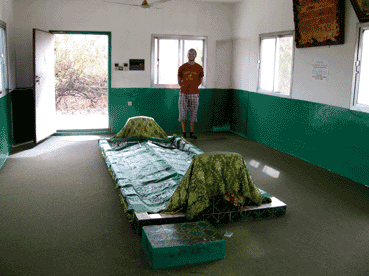
Detailed
guidance was provided by the Blue Water Rally organisers for the transit
past the pirates to Djibouti, and the boats left Oman in small
groups. Unfortunately Stephen
had to return to New Zealand leaving just myself and Anders to set
off nervously towards Djibouti. The first 100 miles we motored in the
company of “Lady in White” (seen opposite), after which we met up
with the four other boats in our group and proceeded in strict
convoy. We would have preferred to sail, but there was very little wind
and we had to keep to an agreed, predetermined
speed.

You can
see four of our convoy in the opposite photo. The
pirate problem was much worse than we had expected. The public only
hears when a ship is successfully attacked; in most cases the attacks are
headed off by the coalition warships. For the three days of the transit we
heard distress calls on Channel 16 VHF sometimes three times a day. On one
occasion we heard a tanker captain calling for assistance from a warship
saying he was being chased by 13 fast boats. The warship immediately sent
off its helicopter gunship and the 13 small boats gave up the chase and
resumed their pretence at being innocent fishing boats – with 400 hp
outboard motors and AK 47s ! It is a perfect example of a ridiculous
asymmetric fight. The rules of engagement do not allow the warships to
fire as required. As soon as a vessel is boarded the warships can do
nothing because of the hostages. One of the groups heard live firing
12 miles ahead of them.
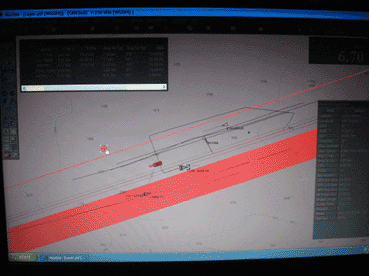
Some of
the warships were impressive. This “stealth” frigate barely showed up
on our radar, and its radar image at 2 miles from our sailing
group made it appear like a small wooden fishing boat. This
is what it actually looked like at 2 miles distance.

We
were delighted and relieved to reach Djibouti. I had expected a quaint,
ex-French, colonial style town. In fact, it was an extremely poor and
relatively uninteresting place. But there are always nice people to
be found anywhere.
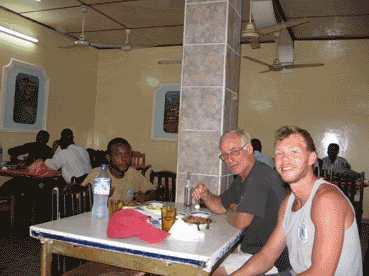
We slipped
quietly out of Djibouti one night to avoid the attention of pirate
spotters, together with 3 other boats. The following afternoon we passed
Bab El Mandeb and were sailing up the Red Sea with a nice following wind
and dolphins to accompany us.
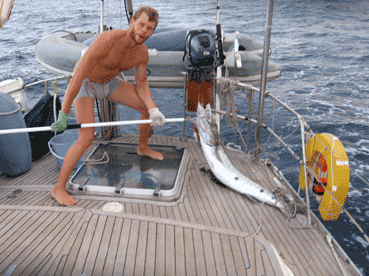
We did
seek shelter on one occasion behind a reef off Sudan together with Prew of
Holland, seen opposite and Lady in White, where we spent the major
part of one day repairing both our headsails.

Anders'
last fish; a wonderful, large, yellow fin tuna, most of which went
into our freezer and three months later, as I write this in the Greek
islands, we still have three portions left to eat. Each de-frosted
portion has provided us with copious amounts of sashimi, which we dip
in a mix of soy and washabi, and also tender steaks, marinated in
lemon, ginger, soy and sesame oil. Delicious!
|

